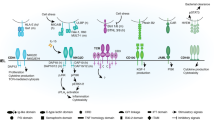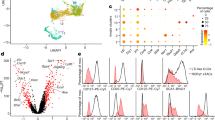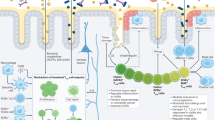Abstract
The γδ T cells are prevalent in the mucosal epithelia and are postulated to act as 'sentries' for maintaining tissue integrity. What these γδ T cells recognize is poorly defined, but given the restricted T cell receptor (TCR) repertoire, the idea that they are selected by self antigens of low complexity has been widely disseminated. Here we present data showing that the generation of the restricted TCR variable γ-region gene repertoire of intestinal intraepithelial lymphocytes was regulated by interleukin 15, which induced local chromatin modifications specific for the variable γ-region gene segment and enhanced accessibility conducive to subsequent targeted gene rearrangement. This cytokine-directed tissue-specific TCR repertoire formation probably reflects distinct TCR repertoire selection criteria for γδ and αβ T cell lineages adopted for different antigen-recognition strategies.
This is a preview of subscription content, access via your institution
Access options
Subscribe to this journal
Receive 12 print issues and online access
$209.00 per year
only $17.42 per issue
Buy this article
- Purchase on Springer Link
- Instant access to full article PDF
Prices may be subject to local taxes which are calculated during checkout





Similar content being viewed by others
Accession codes
References
Chen, Y., Chou, K., Fuchs, E., Havran, W.L. & Boismenu, R. Protection of the intestinal mucosa by intraepithelial γδ T cells. Proc. Natl. Acad. Sci. USA 99, 14338–14343 (2002).
Jameson, J. et al. A role for skin γδ T cells in wound repair. Science 296, 747–749 (2002).
Cheroutre, H. Starting at the beginning: new perspectives on the biology of mucosal T cells. Annu. Rev. Immunol. 22, 217–246 (2004).
Eberl, G. & Littman, D.R. Thymic origin of intestinal αβ T cells revealed by fate mapping of RORγt+ cells. Science 305, 248–251 (2004).
Goodman, T. & LeFrancois, L. Intraepithelial lymphocytes. Anatomical site, not T cell receptor form, dictates phenotype and function. J. Exp. Med. 170, 1569–1581 (1989).
Pereira, P., Lafaille, J.J., Gerber, D. & Tonegawa, S. The T cell receptor repertoire of intestinal intraepithelial γδ T lymphocytes is influenced by genes linked to the major histocompatibility complex and to the T cell receptor loci. Proc. Natl. Acad. Sci. USA 94, 5761–5766 (1997).
Schluns, K.S. et al. Distinct cell types control lymphoid subset development by means of IL-15 and IL-15 receptor α expression. Proc. Natl. Acad. Sci. USA 101, 5616–5621 (2004).
Lefrancois, L., LeCorre, R., Mayo, J., Bluestone, J.A. & Goodman, T. Extrathymic selection of TCR γδ+ T cells by class II major histocompatibility complex molecules. Cell 63, 333–340 (1990).
Grigoriadou, K., Boucontet, L. & Pereira, P. T cell receptor-γ allele-specific selection of Vγ1/Vδ4 cells in the intestinal epithelium. J. Immunol. 169, 3736–3743 (2002).
Correa, I. et al. Most γδ T cells develop normally in β2-microglobulin-deficient mice. Proc. Natl. Acad. Sci. USA 89, 653–657 (1992).
Schweighoffer, E. & Fowlkes, B.J. Positive selection is not required for thymic maturation of transgenic γδ T cells. J. Exp. Med. 183, 2033–2041 (1996).
Pardigon, N., Darche, S., Kelsall, B., Bennink, J.R. & Yewdell, J.W. The TL MHC class Ib molecule has only marginal effects on the activation, survival and trafficking of mouse small intestinal intraepithelial lymphocytes. Int. Immunol. 16, 1305–1313 (2004).
Asarnow, D.M., Cado, D. & Raulet, D.H. Selection is not required to produce invariant T cell receptor γ-gene junctional sequences. Nature 362, 158–160 (1993).
Xiong, N., Kang, C. & Raulet, D.H. Redundant and unique roles of two enhancer elements in the TCRγ locus in gene regulation and γδ T cell development. Immunity 16, 453–463 (2002).
Schlissel, M.S., Durum, S.D. & Muegge, K. The interleukin 7 receptor is required for T cell receptor γ locus accessibility to the V(D)J recombinase. J. Exp. Med. 191, 1045–1050 (2000).
Ye, S.K. et al. The IL-7 receptor controls the accessibility of the TCRγ locus by STAT5 and histone acetylation. Immunity 15, 813–823 (2001).
Kennedy, M.K. et al. Reversible defects in natural killer and memory CD8 T cell lineages in interleukin 15-deficient mice. J. Exp. Med. 191, 771–780 (2000).
Leishman, A.J. et al. T cell responses modulated through interaction between CD8αα and the nonclassical MHC class I molecule, TL. Science 294, 1936–1939 (2001).
Groh, V., Steinle, A., Bauer, S. & Spies, T. Recognition of stress-induced MHC molecules by intestinal epithelial γδ T cells. Science 279, 1737–1740 (1998).
Bauer, S. et al. Activation of NK cells and T cells by NKG2D, a receptor for stress-inducible MICA. Science 285, 727–729 (1999).
Meresse, B. et al. Coordinated induction by IL-15 of a TCR-independent NKG2D signaling pathway converts CTL into lymphokine-activated killer cells in celiac disease. Immunity 21, 357–366 (2004).
Crowley, M.P. et al. A population of murine γδ T cells that recognize an inducible MHC class Ib molecule. Science 287, 314–316 (2000).
Fehniger, T.A. et al. Fatal leukemia in interleukin 15 transgenic mice follows early expansions in natural killer and memory phenotype CD8+ T cells. J. Exp. Med. 193, 219–231 (2001).
Uehara, S., Song, K., Farber, J.M. & Love, P.E. Characterization of CCR9 expression and CCL25/thymus-expressed chemokine responsiveness during T cell development: CD3highCD69+ thymocytes and γδTCR+ thymocytes preferentially respond to CCL25. J. Immunol. 168, 134–142 (2002).
Kang, J. et al. STAT5 is required for thymopoiesis in a development stage-specific manner. J. Immunol. 173, 2307–2314 (2004).
Leclercq, G., Debacker, V., de Smedt, M. & Plum, J. Differential effects of interleukin-15 and interleukin-2 on differentiation of bipotential T/natural killer progenitor cells. J. Exp. Med. 184, 325–336 (1996).
Inagaki-Ohara, K., Nishimura, H., Mitani, A. & Yoshikai, Y. Interleukin-15 preferentially promotes the growth of intestinal intraepithelial lymphocytes bearing γδ T cell receptor in mice. Eur. J. Immunol. 27, 2885–2891 (1997).
Kwon, J., Morshead, K.B., Guyon, J.R., Kingston, R.E. & Oettinger, M.A. Histone acetylation and hSWI/SNF remodeling act in concert to stimulate V(D)J cleavage of nucleosomal DNA. Mol. Cell 6, 1037–1048 (2000).
Malissen, M., Pereira, P., Gerber, D.J., Malissen, B. & DiSanto, J.P. The common cytokine receptor γ chain controls survival of γδ T cells. J. Exp. Med. 186, 1277–1285 (1997).
Kang, J., Coles, M. & Raulet, D.H. Defective development of γδ T cells in interleukin 7 receptor-deficient mice is due to impaired expression of T cell receptor γ genes. J. Exp. Med. 190, 973–982 (1999).
Schlissel, M., Constantinescu, A., Morrow, T., Baxter, M. & Peng, A. Double-strand signal sequence breaks in V(D)J recombination are blunt, 5′-phosphorylated, RAG-dependent, and cell cycle regulated. Genes Dev. 7, 2520–2532 (1993).
McMurry, M.T. & Krangel, M.S. A role for histone acetylation in the developmental regulation of VDJ recombination. Science 287, 495–498 (2000).
Huang, J., Durum, S.K. & Muegge, K. Cutting edge: histone acetylation and recombination at the Tcrg locus follows IL-7 induction. J. Immunol. 167, 6073–6077 (2001).
Baker, J.E., Kang, J., Chen, T., Cado, D. & Raulet, D.H. A novel element upstream of the Vγ2 gene in the murine T cell receptor γ locus cooperates with the 3′ enhancer to act as a locus control region. J. Exp. Med. 190, 669–680 (1999).
Goldman, J., Spencer, D. & Raulet, D. Ordered rearrangement of variable region genes of the T cell receptor γ locus correlates with transcription of the unrearranged genes. J. Exp. Med. 177, 729–739 (1993).
Agata, Y. et al. Histone acetylation determines the developmentally regulated accessibility for T cell receptor γ gene recombination. J. Exp. Med. 193, 873–880 (2001).
Reinecker, H.C., MacDermott, R.P., Mirau, S., Dignass, A. & Podolsky, D.K. Intestinal epithelial cells both express and respond to interleukin 15. Gastroenterology 111, 1706–1713 (1996).
Murray, A.M., Simm, B. & Beagley, K.W. Cytokine gene expression in murine fetal intestine: potential for extrathymic T cell development. Cytokine 10, 337–345 (1998).
Guy-Grand, D. et al. Extrathymic T cell lymphopoiesis: ontogeny and contribution to gut intraepithelial lymphocytes in athymic and euthymic mice. J. Exp. Med. 197, 333–341 (2003).
Nonaka, S. et al. Intestinal γδ T cells develop in mice lacking thymus, all lymph nodes, Peyer's patches, and isolated lymphoid follicles. J. Immunol. 174, 1906–1912 (2005).
Ye, S. et al. Induction of germline transcription in the TCRγ locus by STAT5: Implications for accessibility control by the IL-7 receptor. Immunity 11, 213–223 (1999).
Teglund, S. et al. STAT5a and STAT5b proteins have essential and non-essential, or redundant, roles in cytokine responses. Cell 93, 841–850 (1998).
Cui, Y. et al. Inactivation of Stat5 in mouse mammary epithelium during pregnancy reveals distinct functions in cell proliferation, survival, and differentiation. Mol. Cell. Biol. 24, 8037–8047 (2004).
Xiong, N., Kang, C. & Raulet, D.H. Positive selection of dendritic epidermal γδ T cell precursors in the fetal thymus determines expression of skin-homing receptors. Immunity 21, 121–131 (2004).
Laky, K. et al. Enterocyte expression of interleukin 7 induces development of γδ T cells and Peyer's patches. J. Exp. Med. 191, 1569–1580 (2000).
Perumal, N.B. et al. TCR-γ genes are rearranged but not transcribed in IL-7Rα-deficient mice. J. Immunol. 158, 5744–5750 (1997).
Meyer, T., Hendry, L., Begitt, A., John, S. & Vinkemeier, U. A single residue modulates tyrosine dephosphorylation, oligomerization, and nuclear accumulation of STAT transcription factors. J. Biol. Chem. 279, 18998–19007 (2004).
Moriggl, R. et al. STAT5 tetramer formation is associated with leukemogenesis. Cancer Cell 7, 87–99 (2005).
Pereira, P. & Boucontet, L. Rates of recombination and chain pair biases greatly influence the primary γδ TCR repertoire in the thymus of adult mice. J. Immunol. 173, 3261–3270 (2004).
Fujihashi, K. et al. Interleukin 2 (IL-2) and interleukin 7 (IL-7) reciprocally induce IL-7 and IL-2 receptors on γδ T-cell receptor-positive intraepithelial lymphocytes. Proc. Natl. Acad. Sci. USA 93, 3613–3618 (1996).
Damjanovich, S. et al. Preassembly of interleukin 2 (IL-2) receptor subunits on resting Kit 225 K6 T cells and their modulation by IL-2, IL-7, and IL-15: a fluorescence resonance energy transfer study. Proc. Natl. Acad. Sci. USA 94, 13134–13139 (1997).
Kronenberg, M. & Gapin, L. The unconventional lifestyle of NKT cells. Nat. Rev. Immunol. 2, 557–568 (2002).
Treiner, E. et al. Selection of evolutionarily conserved mucosal-associated invariant T cells by MR1. Nature 422, 164–169 (2003).
Xiong, N., Baker, J.E., Kang, C. & Raulet, D.H. The genomic arrangement of T cell receptor variable genes is a determinant of the developmental rearrangement pattern. Proc. Natl. Acad. Sci. USA 101, 260–265 (2004).
Acknowledgements
We thank D.H. Raulet for initial support of this work; C. Chambers for discussions; M. Caligiuri, J. Ihle and J. Peschon for Il15-transgenic, FL-STAT5–deficient and Il15−/− mice, respectively; D.H. Raulet, W. Held, L. Berg, M. Bix and members of the lab for critical comments on the manuscript; and K. Pinault and T. Mascenik for assistance with animal husbandry.
Author information
Authors and Affiliations
Corresponding author
Ethics declarations
Competing interests
The authors declare no competing financial interests.
Supplementary information
Supplementary Fig. 1
Effects of IL-15 in the generation of Vγ5+ γδ T cells. (PDF 265 kb)
Supplementary Table 1
DNA sequences of PCR primers. (PDF 68 kb)
Rights and permissions
About this article
Cite this article
Zhao, H., Nguyen, H. & Kang, J. Interleukin 15 controls the generation of the restricted T cell receptor repertoire of γδ intestinal intraepithelial lymphocytes. Nat Immunol 6, 1263–1271 (2005). https://doi.org/10.1038/ni1267
Received:
Accepted:
Published:
Issue Date:
DOI: https://doi.org/10.1038/ni1267
This article is cited by
-
In respond to commensal bacteria: γδT cells play a pleiotropic role in tumor immunity
Cell & Bioscience (2021)
-
Function of γδ T cells in tumor immunology and their application to cancer therapy
Experimental & Molecular Medicine (2021)
-
Adoptive cell therapy of patient-derived renal cell carcinoma xenograft model with IL-15-induced γδT cells
Medical Oncology (2021)
-
γδ T cells in homeostasis and host defence of epithelial barrier tissues
Nature Reviews Immunology (2017)
-
Transcriptional programs define molecular characteristics of innate lymphoid cell classes and subsets
Nature Immunology (2015)



